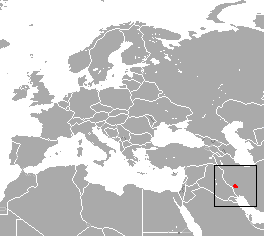
Dipsas variegata, the variegated snail-eater, is a snake found in South America. It is reported to feed almost exclusively on tree snails and slugs.

Oecomys trinitatis, also known as the long-furred oecomys, long-furred rice rat, Trinidad arboreal rice rat, or big arboreal rice rat, is a species of rodent in the genus Oecomys of family Cricetidae. As currently constituted, it has a wide distribution in Central America and South America, being found in southern Costa Rica, Panama, Colombia, Venezuela, Trinidad and Tobago, Guyana, Suriname, French Guiana, much of Brazil, eastern Ecuador, and eastern Peru.

An IUCN Red List Critically Endangered species is one that has been categorized by the International Union for Conservation of Nature as facing an extremely high risk of extinction in the wild. As of 2021, of the 120,372 species currently tracked by the IUCN, there are 8,404 species that are considered to be Critically Endangered.

The charming thicket rat is a species of rodent in the family Muridae. It is described as data deficient as Thamnomys schoutedeni. It is found in Democratic Republic of the Congo, Rwanda, and Uganda. Its natural habitat is subtropical or tropical moist montane forests. It is threatened by habitat loss.

The yellow-throated frog, Trinidadian stream frog, or Trinidad poison frog is a diurnal species of frog in the family Aromobatidae that is endemic to the island of Trinidad in the Republic of Trinidad and Tobago. Trinidad poison frogs can be found in rocky streams in moist montane forests. The species has cryptic coloration and is sexually dimorphic. Mannophryne venezuelensis from the Paria Peninsula in Venezuela were also formerly included in this species. Currently this species is listed as of "Least Concern" on IUCN, but there is a general lack of understanding of its distribution. The frog experiences habitat loss. Both sexes are territorial and provide parental care together.

The Trinidad spiny rat is a species of rodent in the family Echimyidae. It is found in Trinidad and Tobago and northern Venezuela.

The Somali hedgehog is a species of mammal in the family Erinaceidae. It is endemic to Somalia and Somaliland. The Somali hedgehog is nocturnal.

The Ugandan lowland shrew or Moon shrew, is a species of mammal in the family Soricidae. It is found in Kenya and Uganda. Its natural habitats are subtropical or tropical swamps and montane forests.

The Iranian shrew is a species of mammal in the family Soricidae. It is endemic to Iran. It is threatened by habitat loss.

Pearson's long-clawed shrew is a species of mammal in the family Soricidae. It is the only species within the genus Solisorex. It is endemic to Sri Lanka. Its natural habitats are subtropical or tropical dry forests and lowland grasslands. It is threatened by habitat loss. It is named after Joseph Pearson FRSE, Director of the Columbo Museum 1910-1933 who found it on 1 January 1924.

Day's shrew is a species of mammal in the family Soricidae. It is endemic to India. Its natural habitat is subtropical or tropical dry forests. It is threatened by habitat loss.

The Mount Cameroon forest shrew or arrogant shrew, is a species of mammal in the family Soricidae endemic to Cameroon. Its natural habitat is subtropical or tropical moist montane forests.
Hypolestes clara is a species of damselfly in the family Hypolestidae. It is endemic to Jamaica. Its natural habitats are subtropical or tropical moist lowland forests and rivers. It is threatened by habitat loss.
Oecomys catherinae, also known as the Atlantic Forest oecomys, is a species of rodent in the genus Oecomys from eastern Brazil.

Anolis trinitatis, also known as Saint Vincent bush anole, Saint Vincent's bush anole, or the Trinidad anole, is a species of anole lizard found in the Caribbean.
Ophioblennius trinitatis is a species of combtooth blenny endemic to the southwest Atlantic ocean. It is a subtropical marine fish commonly found in reefs off the coast of Brazil. Combtooth blennies are often referred to as "peixes-macacos" in Brazil, which translates to "monkey-fish".

The Trinidad dog-like bat is a species of bat from the family Emballonuridae. It is native to Aruba, French Guiana, Grenada, Trinidad and Tobago, and Venezuela. The bat is considered to be rare everywhere in its geographic range, although this may be untrue, as the Trinidad dog-like bat was previously confused with the lesser dog-like bat. It is an aerial insectivore that roosts in hollow trees, hollow rotten logs on the ground, under overhanging banks, and caves in the Llanos of Venezuela.

The brown weeper capuchin or Venezuelan brown capuchin is a species of gracile capuchin monkey endemic to Venezuela, although some sources also consider it to occur on Trinidad.
The Trinidad white-fronted capuchin is a subspecies or species of gracile capuchin monkey. It is found on the island of Trinidad.

Bachia trinitatis, commonly known as the Trinidad bachia or Trinidad worm lizard, is a species of lizard in the family Gymnophthalmidae. It is endemic to Trinidad and Tobago.
















